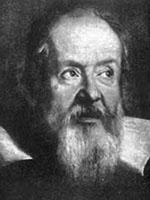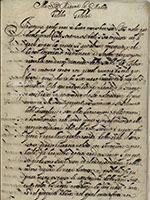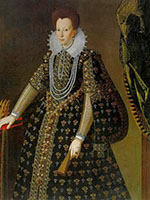
Luca Arcangeli
Fondazione Istituto Tecnico Superiore per le Tecnologie dell'Informazione e della Comunicazione
The letter to the grand duchess of Toscana, Christina of Lorraine, was started by Galilei in the February of 1615 and completed only in the summer of that year. Such a long time of writing can be justified by the length of the work, which seems more like a brief theoretical treaty than a letter of clarification.
It was a crucial moment for the scientific activity of Galilei: from when, in 1610, his Sidereus Nuncius, began to circulate in all Europe, the Copernican theory became no longer a mere hypothesis or a useful means to simplify the astronomic calculations, but a proper thesis, that, from the observations, seemed to be soon theoretically demonstrable, so almost ready to undermine the old dominion of geocentricism. To debunk the time-honoured Aristotle-Ptolemaic Cosmology meant to destroy the anthropocentric image of the universe, which had been consolidating during all the medieval ages. As a result, the issue of the veracity of the Copernican theory fast moved from the philosophical soil to the religious and theological one. This move was also helped by the cultural mood after the Tridentine Council, which, through means such as the List of Prohibited Books, favoured the ecclesiastical supervision of the intellectual production.
 Galilei was conscious of the risk he and his theories would run in case he was declared a heretic, but at the same time, after years of research, he was also absolutely sure of the truthfulness of the heliocentric theory. Between 1611 and 1615 his challenge was therefore to conciliate the Copernican theory and the Christian faith. A serious obstacle here was the hostility of some verses in the Holy Scriptures, such as Js 10:12-13, where Josue orders the sun to stop at the battle of Gabaon. The use of the Bible was almost spontaneous in the scientific disputes of the time, when the natural philosophy tended to be absorbed in a Christianly-oriented metaphysics of the sensible or when the natural was read as a symbol of the supernatural. As a consequence, Galilei was forced to reflect upon the interpretation criteria of the Bible to understand whether the latter was really such a threat.
Galilei was conscious of the risk he and his theories would run in case he was declared a heretic, but at the same time, after years of research, he was also absolutely sure of the truthfulness of the heliocentric theory. Between 1611 and 1615 his challenge was therefore to conciliate the Copernican theory and the Christian faith. A serious obstacle here was the hostility of some verses in the Holy Scriptures, such as Js 10:12-13, where Josue orders the sun to stop at the battle of Gabaon. The use of the Bible was almost spontaneous in the scientific disputes of the time, when the natural philosophy tended to be absorbed in a Christianly-oriented metaphysics of the sensible or when the natural was read as a symbol of the supernatural. As a consequence, Galilei was forced to reflect upon the interpretation criteria of the Bible to understand whether the latter was really such a threat.
Thanks maybe to a Barnabite father, who provided Galilei with a folder of old and modern texts on the relationship between scientific research and biblical exegesis, Galilei could verify and base his ideas on the tradition of the Church itself and he discovered in St. Augustine a formidable ally. Indeed, already more than a thousand years before, the fathers of the Church came across very similar difficulties as Galilei’s in their attempt to conciliate the Hebrew-Christian result with the refined Greek and Roman speculation. As St. Augustine had to face the historical challenge of the enculturation of the Biblical language inside the domain of the elegant classic reflection symbolised by Cicero’s Ortensio, Galilei had to conciliate a truth of the reason and an apparently adverse religious thought within an already Christian context. The methodological revolution that was happening in the field of natural philosophy had the inevitable effect of a clarification in the relationship between this form of knowledge and the Holy Scriptures.
 The letter to Madam Christina of Lorraine represents the more mature theoretical attempt on the part of Galilei in this effort to clarify and restructure the relationship between natural philosophy and the Scriptures, an attempt which aimed at relieving the Bible from its role as a source of authority in the field of scientific research. In the letter Galilei used four fundamental theoretical principles: the principle of inerrancy (i.e. it is impossible for the Bible to contain erroneous affirmations), the principle of the only source of truth (i.e. the Scriptures and Nature both derive from God, the former as His word and the latter as His work), the principle of limitation (i.e. the primary aim of the Bible is the salvation of mankind), the principle of prudence (i.e. it is necessary to be very careful with the interpretation of the Scriptures to avoid the latter support wrong theses). Galilei used these four principles to found the key concept that should have guaranteed the autonomy of research of the natural philosophy from the authority of the sacred text: it is never methodologically correct to use biblical verses as experimental proofs. This criterion could already have been found in St. Augustine’s De Genesi ad Litteram and it is therefore not by chance that Galilei abundantly cites from it. According to Galilei, the Bible should be scientifically relieved of responsibilities because, although both nature and the Scriptures come from the word of God, the two differ both for their language (polyphonic and plural for the Scriptures and linear and monotonous for nature) and for their scopes (the Bible aims at spreading truths otherwise inaccessible whereas nature follows the immutable and necessary laws wanted by God). The book of nature is univocal, it speaks limpidly, without metaphors or allusions, for those who possess the geometric-mathematic language. On the contrary, the Holy Scriptures are a complex and multi-layered text, and they need a careful work of interpretation: behind an often bitter language, used to adapt to the understanding of the common man, the Bible hides treasures of wisdom for the scholars.
The letter to Madam Christina of Lorraine represents the more mature theoretical attempt on the part of Galilei in this effort to clarify and restructure the relationship between natural philosophy and the Scriptures, an attempt which aimed at relieving the Bible from its role as a source of authority in the field of scientific research. In the letter Galilei used four fundamental theoretical principles: the principle of inerrancy (i.e. it is impossible for the Bible to contain erroneous affirmations), the principle of the only source of truth (i.e. the Scriptures and Nature both derive from God, the former as His word and the latter as His work), the principle of limitation (i.e. the primary aim of the Bible is the salvation of mankind), the principle of prudence (i.e. it is necessary to be very careful with the interpretation of the Scriptures to avoid the latter support wrong theses). Galilei used these four principles to found the key concept that should have guaranteed the autonomy of research of the natural philosophy from the authority of the sacred text: it is never methodologically correct to use biblical verses as experimental proofs. This criterion could already have been found in St. Augustine’s De Genesi ad Litteram and it is therefore not by chance that Galilei abundantly cites from it. According to Galilei, the Bible should be scientifically relieved of responsibilities because, although both nature and the Scriptures come from the word of God, the two differ both for their language (polyphonic and plural for the Scriptures and linear and monotonous for nature) and for their scopes (the Bible aims at spreading truths otherwise inaccessible whereas nature follows the immutable and necessary laws wanted by God). The book of nature is univocal, it speaks limpidly, without metaphors or allusions, for those who possess the geometric-mathematic language. On the contrary, the Holy Scriptures are a complex and multi-layered text, and they need a careful work of interpretation: behind an often bitter language, used to adapt to the understanding of the common man, the Bible hides treasures of wisdom for the scholars.
Given Galilei’s pretence to give an absolute autonomy of research to the natural sciences, it is now necessary to underline how Galilei persisted in his belief, which he shared with his opponents, that the Bible was an encyclopaedia of the whole human knowledge. This is evident in the ending of the letter to Madam Christina of Lorraine where Galilei goes from the level of enunciation of theoretical principles, to the exegetic applicative one: a Copernican reading of the Bible is not only possible, but it actually leads to a simpler interpretation of the biblical verses, compared to the adoption of the Ptolemaic system. Galilei will never go as far as to affirm that the Bible is radically unscientific, the Scriptures certainly have the spiritual salvation of the believer as their primary scope, but at the same time they contain every truths of knowledge. According to Galilei, it was possible to read biblical passages scientifically: starting from the truths already proved by the experimental research, it is then possible to interpret the Scriptures, discovering how scientific truths can lead to a deeper understanding of the biblical verses. This idea of the Bible as a mystery book, or in other words, as an esoteric holder of the whole human knowledge, was typical of the Renaissance culture: what Galilei and his contemporary Biblicists lacked was a clear awareness of the historical and literal formulation of the Bible. This lack of awareness was one of the main reasons for the condemnation of the Copernican theory in 1616.
In conclusion, the letter to Madam Christina of Lorraine represents, both with its extraordinary intuitions and limits, the attempt to re-decline the epistemological and authoritative position of the Holy Scriptures in comparison with the new research methodology typical of the modern sciences. This attempt is set within a bigger reconsideration of the relationship between reason and faith in every fields of European civilisation, where events such as the discovery of America, the Reformation and the Copernican revolution had made the old medieval harmony obsolete. A few decades after the letter to Madam Christina of Lorraine, great thinkers, such as Thomas Hobbes and Baruch Spinoza would pave the way for an enlightened reading of the Bible, abandoning the by now frustrated Galilean conciliating spirit and launching a direct attack to the revelation, in favour of a rationalist and ultimately deist approach. It was now science itself that took over the Bible, destroying its autonomy of faith and re-reading it in a rationalistic way as a mere historic document. However, it was precisely from such an alien view that a great gift to men of faith would come: as a matter of fact, the historic-critical method, far from desacralizing the Scriptures as some had thought, allowed a closer examination of their historic and literary dimension. At the same time, science progressively released itself from those materialistic and positivistic readings which led it to its self-comprehension in modern times and this has opened to new and fruitful ways of dialogue between science and faith.
